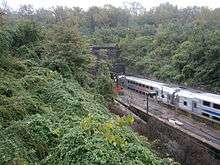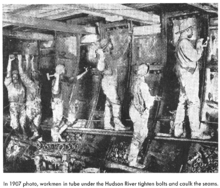North River Tunnels
 Western portal at Bergen Hill | |||||||||||||||||||||||||||||||||||||
| Overview | |||||||||||||||||||||||||||||||||||||
|---|---|---|---|---|---|---|---|---|---|---|---|---|---|---|---|---|---|---|---|---|---|---|---|---|---|---|---|---|---|---|---|---|---|---|---|---|---|
| Line | Northeast Corridor | ||||||||||||||||||||||||||||||||||||
| Location | Hudson Palisades-Hudson River | ||||||||||||||||||||||||||||||||||||
| Coordinates | 40°45′31″N 74°00′45″W / 40.7585°N 74.0125°WCoordinates: 40°45′31″N 74°00′45″W / 40.7585°N 74.0125°W | ||||||||||||||||||||||||||||||||||||
| System | Amtrak and NJ Transit | ||||||||||||||||||||||||||||||||||||
| Start | Secaucus Junction in Secaucus (NJT); Newark Pennsylvania Station in Newark (Amtrak) | ||||||||||||||||||||||||||||||||||||
| End | |||||||||||||||||||||||||||||||||||||
| |||||||||||||||||||||||||||||||||||||
The North River Tunnels are a pair of tunnels[4]:52 that carry Amtrak and New Jersey Transit rail lines under the Hudson River between Weehawken, New Jersey and Pennsylvania Station in Manhattan, New York City. Built between 1904 and 1908 by the Pennsylvania Railroad (PRR) to allow its trains to reach Manhattan, they opened for passenger service in late 1910.[5]
Design and construction

Led by Chief Engineer Charles M. Jacobs, the tunnel design team began work in 1902. After plans were complete in 1904, the first task was digging two shafts, one just east of 11th Avenue in Manhattan and a larger one a few hundred yards west of the river. The Weehawken Shaft was completed in September 1904 as a concrete-walled rectangular pit, 56 by 116 ft (17.1 by 35.4 m) at the bottom and 76 ft (23.2 m) deep.
When the shafts were complete, O'Rourke Engineering Construction Company began work on the tunnels proper. The project was divided into three parts, each managed by a resident engineer: The "Terminal Station" in Manhattan; the "River Tunnels", east from the Weehawken Shaft and under the Hudson River; and the Bergen Hill tunnels, west from the Weehawken Shaft to the tunnel portals on the west side of the Palisades.[4]:45 (At the time, "North River Tunnels" referred to the tunnels east of the Weehawken Shaft; in later years the term has come to include the Bergen Hill tunnels as well.)
The tunnels were built with drilling and blasting techniques and tunnelling shields,[6] digging west from Manhattan, east and west from Weehawken, and east from the Bergen portals.
Under the river itself, the tunnels started in rock, using drill and blast, but the strata under the river was pure mud for a considerable depth, so this part was driven under compressed air, using a Greathed shield, and lined with cast-iron segments bolted together. The mud was such that the shield was shoved blind, i.e. taking in no ground at all. But it was found easier to steer if some mud was taken in through holes at the front. The mud was the consistency of toothpaste.
The two ends of the northern tube under the river met in September 1906; at that time it was the longest underwater tunnel in the world.[3][7]
Meanwhile, the John Shields Construction Company had begun in 1905 to bore through Bergen Hill, the lower Hudson Palisades;[8] William Bradley took over in 1906 and the tunnels to the Hackensack Meadows were completed in April 1908.[9][10]
The west portals are in North Bergen, at the west edge of the New Jersey Palisades near the east end of Route 3 at U.S. Route 1/9 (40°46′17″N 74°02′31″W / 40.7714°N 74.0419°W). They run beneath North Bergen, Union City, and Weehawken, to the east portals at the east edge of 10th Avenue at 32nd St in Manhattan. (Since 1968 the east portals have been hidden beneath 450 West 33rd Street on the east side of 10th Ave.) When the top of the Weehawken Shaft was covered is a mystery; the two tracks may have remained open to the sky until catenary was added circa 1932.
Except for a curve west of the west end of Pier 72 that totals just under a degree, the two tracks are straight (in plan view); they are 37 feet (11.3 m) apart from west of 11th Avenue to the Bergen Hill portals. The third rail now ends just west of the Bergen Hill portals.
Operation and useful life



Since 2003, the tunnels have operated near capacity during peak hours.[2] Trains ordinarily travel west (to New Jersey) through the north tube and east (to Manhattan) through the south. During the busiest hour of morning rush, about 24 trains are scheduled through the south tube, and the same through the north tube in the afternoon.
In June 2009, the Access to the Region's Core project began building a set of parallel tunnels to supplement the North River Tunnels, but that project was canceled in October 2010 by New Jersey Governor Chris Christie, who cited budgets constraints. On February 7, 2011, Amtrak announced that it would spend $50 million on preliminary engineering and design work for a new tunnel project called the Gateway Project, estimated to cost $13.5 billion.[11]
The unprecedented storm surge from Hurricane Sandy flooded one of the North River Tunnels for the first time,[12] damaging overhead wires, electrical systems, concrete bench walls, and drainage systems.[13]
In May 2014, Amtrak CEO Joseph Boardman told the Regional Plan Association that less than 20 years remained before one or both of the tunnels would have to be shut down.[14]
See also
- Bergen Hill
- East River Tunnels
- List of bridges, tunnels, and cuts in Hudson County, New Jersey
- List of ferries across the Hudson River in New York City
- List of fixed crossings of the Hudson River (bridges and tunnels)
- New York Tunnel Extension (construction project for North River Tunnels)
- Uptown Hudson Tubes (PATH transit tunnels, opened 1908)
References
- ↑ Guide to Civil Engineering Projects In and Around New York City (2nd ed.). Metropolitan Section, American Society of Civil Engineers. 2009. p. 58.
- 1 2 Belson, Ken (2008-04-06). "Tunnel Milestone, and More to Come". The New York Times. Retrieved 2011-10-09.
- 1 2 3 "'Pennsy's' North River Tunnel a Marvel of Skill; Bores Meeting Head-on Under the River Only an Eighth of an Inch Out of Alignment and Three-fourths of an Inch Out of Grade" (PDF). The New York Times. September 9, 1906.
- 1 2 Jacobs, Charles M. (Sep 1910). "The New York Tunnel Extension of the Pennsylvania Railroad, The North River Division.". Transactions of the American Society of Civil Engineers. American Society of Civil Engineers. LXVIII. Retrieved 7 October 2014.
- ↑ Cudahy, Brian J. (2002). Rails Under the Mighty Hudson (2nd ed.). New York: Fordham University Press. ISBN 0-8232-2190-3. OCLC 48376141.
- ↑ Hewett, B.H.M. (1912). "The North River Division". History of the Engineering Construction and Equipment of the Pennsylvania Railroad Company's New York Terminal and Approaches. New York: Isaac H. Blanchard Co. pp. 35–53.
- ↑ "Meeting of the Pennsylvania Tunnel Shields". The Railway Age. Chicago: Wilson Co. 42 (12): 355. 1906-09-21.
- ↑ "Penn. Tunnel Award". The New York Times. March 14, 1905. Retrieved 2011-02-27.
- ↑ "Final Blast Opens Pennsylvania Tube". The New York Times. April 9, 1908. Retrieved 2011-02-27.
- ↑ "Another Tube Through". The New York Times. April 11, 1908. Retrieved 2011-02-27.
- ↑ "Senators propose tunnel linking New York and New Jersey". BBC. 2011-02-07. Retrieved 2011-10-09.
- ↑ Frassinelli, Mike (November 8, 2012). "Transportation update: Amtrak to reopen flooded Hudson River rail tunnel". The Star Ledger.
- ↑ Higgs, Larry (September 1, 2014). "Amtrak: New tunnels needed after Sandy damage". Asbury Park Press. Retrieved 2014-09-30.
- ↑ Rubinstein, Dana (May 5, 2014). "Clock ticking on Hudson crossings, Amtrak warns". Capital. Retrieved 2014-05-20.
External links
-
 Media related to North River Tunnels at Wikimedia Commons
Media related to North River Tunnels at Wikimedia Commons - Reeve, Arthur B. (December 1906). "The Romance of Tunnel Building: The Sixteen Subaqueous Tunnels Built and Building Under the Rivers Around New York City". The World's Work: A History of Our Time. XIII: 8338–8351. Retrieved 2009-07-10. Includes numerous construction photos.
- Animated graphic of North River Tunnel construction technique - The New York Times
- "Tunnel to Terminus: The Story of Penn Station" - National Public Radio
- "Bergen Interlocking", The LIRR Today (registration required)
